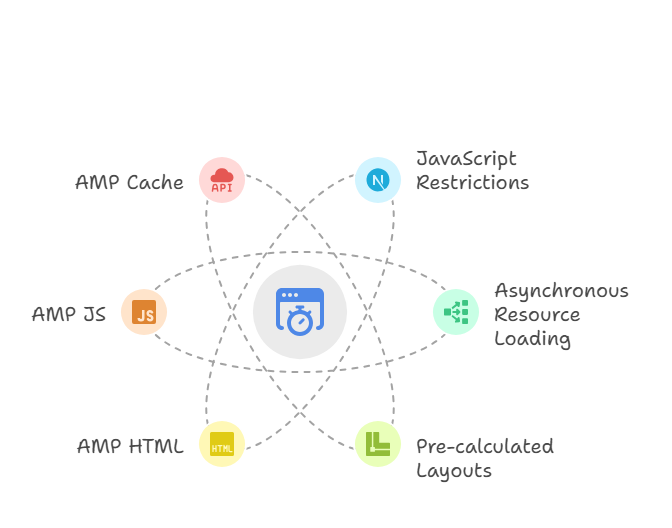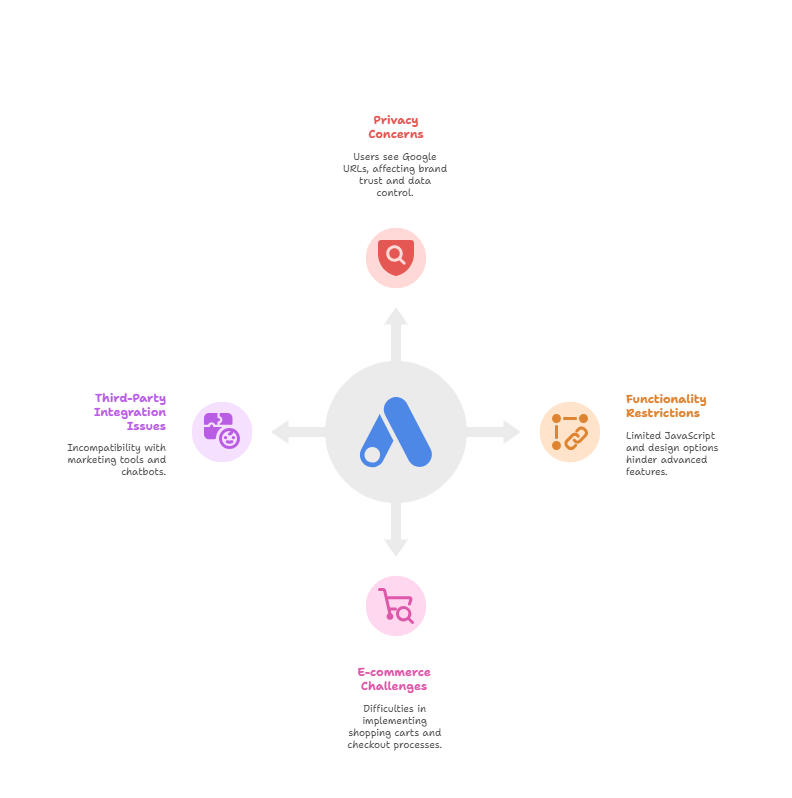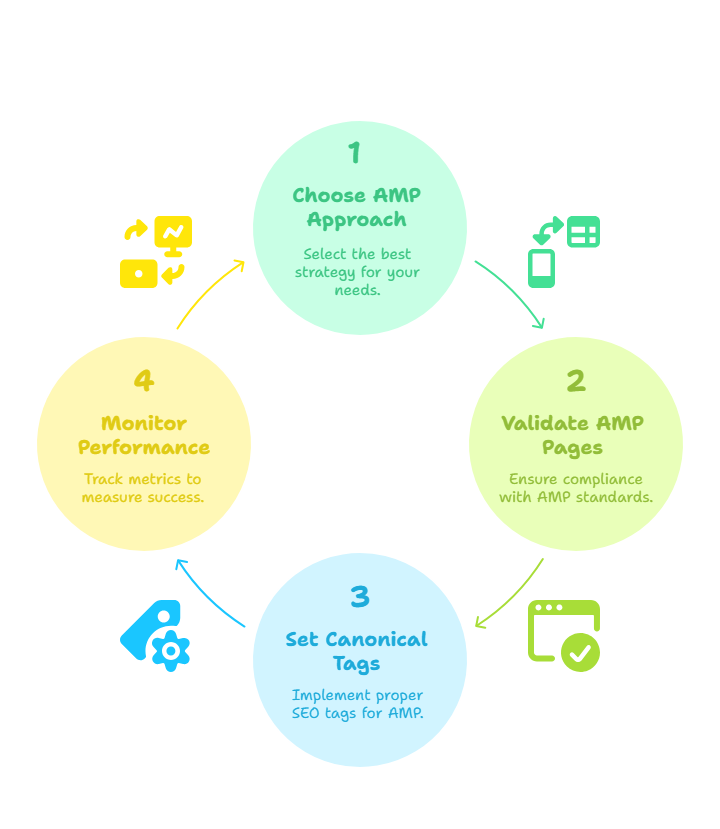Mobile page speed can make or break your website’s success. When Google introduced Accelerated Mobile Pages (AMP) in 2015, it promised lightning-fast loading times that would revolutionize mobile browsing. But the digital landscape has evolved dramatically since then, and so have Google’s ranking criteria.
With Core Web Vitals now taking center stage and new mobile optimization technologies emerging, many website owners are questioning whether AMP still delivers the competitive edge it once promised.
The answer isn’t as straightforward as you might think.
This comprehensive guide examines AMP’s current relevance in 2025, analyzes real-world performance data, and provides actionable insights to help you make informed decisions about mobile optimization.
Whether you’re considering implementing AMP or wondering if it’s time to move on, we’ll cover everything you need to know.
What Are AMP Pages?
AMP (Accelerated Mobile Pages) is an open-source web component framework originally developed by Google to create ultra-fast mobile web experiences. Think of it as a streamlined version of HTML that eliminates performance-hindering elements while preserving essential functionality.
When you see those distinctive lightning bolt icons next to search results on mobile devices, you’re looking at AMP pages. These pages are designed to load in under one second, even on slower 3G connections, by adhering to strict coding standards and leveraging Google’s global content delivery network.
“AMP fundamentally changed how we think about mobile web performance by forcing developers to prioritize content delivery over flashy features.” – Barry Schwartz, Search Engine Land
Unlike traditional web pages that can include unlimited JavaScript and CSS, AMP pages operate within carefully defined constraints that ensure consistent performance across all devices and network conditions.
Why AMP Was Created
In 2015, mobile web browsing was plagued by frustratingly slow load times. Google’s research showed that 53% of mobile users abandoned pages that took longer than three seconds to load, creating a massive user experience problem across the web.
Google identified several key issues that AMP was designed to address:
- Inconsistent mobile performance: Websites performed vastly differently across devices and network conditions
- Heavy JavaScript execution: Complex scripts were blocking page rendering and slowing content delivery
- Unoptimized resource loading: Images, ads, and third-party scripts loaded inefficiently
- Layout instability: Elements shifted around as pages loaded, creating poor user experiences
According to Google’s initial AMP announcement, the framework was designed to make the mobile web “work better for everyone” by establishing universal performance standards.
How AMP Works
Simplified Code Structure

AMP achieves its speed through a combination of strict technical constraints and intelligent resource management. The framework operates on three core principles that fundamentally change how web pages are constructed and delivered.
First, JavaScript restrictions eliminate render-blocking scripts. AMP prohibits custom JavaScript in favor of pre-optimized AMP components. This ensures that no poorly written scripts can slow down page loading or cause performance bottlenecks.
Second, asynchronous resource loading allows different page elements to load independently. Images, ads, and embedded content load in the background without blocking text and critical page elements, ensuring users can start reading immediately.
Third, pre-calculated layouts prevent content shifting during load. AMP requires developers to specify exact dimensions for all page elements, eliminating Cumulative Layout Shift (CLS) issues that Google now measures as part of Core Web Vitals.
AMP HTML, AMP JS, and AMP Cache
The AMP ecosystem consists of three interconnected components that work together to deliver exceptional performance:
- AMP HTML: A restricted version of HTML that replaces standard tags with AMP-specific elements. Instead of
<img>, you use<amp-img>with required width and height attributes. These specialized tags enable better optimization and lazy loading. - AMP JS: A high-performance JavaScript runtime that manages resource loading, prioritizes visible content, and handles user interactions. This 50KB library replaces potentially megabytes of custom JavaScript while maintaining essential functionality.
- AMP Cache: Google’s global content delivery network that stores, validates, and serves AMP pages. When users click AMP results, they often receive content directly from Google’s servers, dramatically reducing latency.
“The genius of AMP lies in its constraint-based approach – by limiting what developers can do, it guarantees what users will experience.” – John Mueller, Google Search Advocate
Benefits of Using AMP (Then and Now)
What AMP Used to Offer
Between 2015 and 2021, AMP provided several compelling advantages that made it nearly essential for content publishers and news websites:
- Guaranteed Top Stories inclusion: AMP was a hard requirement for appearing in Google’s prominent news carousel, giving publishers a significant visibility advantage
- Exceptional load speeds: AMP pages loaded 85% faster than equivalent non-AMP pages, dramatically improving user retention
- Improved mobile search rankings: While not officially a ranking factor, faster pages generally performed better in mobile search results
- Enhanced user engagement: Publishers reported 2x lower bounce rates and 3x longer session durations on AMP pages
During this period, major publishers like The Washington Post, BBC, and CNN heavily invested in AMP implementations, seeing significant traffic increases from mobile search.
What AMP Offers in 2025
The landscape has shifted considerably, but AMP still provides several valuable benefits for specific use cases:
- Consistently fast mobile performance: AMP pages continue to deliver sub-second load times across all devices and network conditions
- Simplified content consumption: The stripped-down design eliminates distractions, creating a reading-focused experience that many users prefer
- Reduced server load: Google’s AMP Cache handles traffic spikes and reduces bandwidth costs for content publishers
- International accessibility: AMP’s aggressive optimization benefits users in regions with slower internet infrastructure
However, the most significant change is that AMP is no longer required for Top Stories. Google’s May 2021 Core Web Vitals update opened this feature to any page meeting performance thresholds, fundamentally altering AMP’s value proposition.
Is AMP Still Good for SEO in 2025?
AMP vs Core Web Vitals (CWV)
The introduction of Core Web Vitals as ranking signals in May 2021 fundamentally changed AMP’s SEO relevance. Google now evaluates page experience using three specific metrics regardless of whether pages use AMP:
- Largest Contentful Paint (LCP): Measures loading performance (should be under 2.5 seconds)
- First Input Delay (FID): Measures interactivity (should be under 100 milliseconds)
- Cumulative Layout Shift (CLS): Measures visual stability (should be under 0.1)
Google’s official announcement clarified that any page meeting Core Web Vitals thresholds can benefit from page experience signals, not just AMP pages.
“Core Web Vitals leveled the playing field. Now it’s about delivering great user experiences, regardless of the technology stack you choose.” – Barry Adams, State of Digital
Performance Comparisons in Real-World SEO
Recent data reveals that AMP’s SEO advantages have diminished significantly:
- Non-AMP pages frequently outrank AMP versions: Sistrix’s 2023 analysis found that well-optimized regular pages often achieve better search visibility than their AMP counterparts
- Progressive Web Apps match AMP speed: Modern PWAs consistently achieve Core Web Vitals compliance while maintaining full functionality
- Server-side rendering delivers comparable performance: Frameworks like Next.js and Nuxt.js enable sub-second load times without AMP’s restrictions
The key insight: speed matters more than the technology used to achieve it. Google’s algorithms now reward fast, user-friendly experiences regardless of implementation approach.
Case Studies and Data
Several major publishers have moved away from AMP with positive results:
The Guardian transitioned from AMP to a custom mobile-optimized solution in 2022. Their internal data showed a 12% increase in mobile page views and 8% improvement in user engagement after the switch.
Wired Magazine replaced AMP with a Progressive Web App approach, resulting in 25% faster load times and significantly improved reader retention. Their custom solution maintained sub-second loading while enabling personalized content recommendations.
These examples demonstrate that with proper optimization, non-AMP solutions can deliver superior performance and user experience while maintaining SEO effectiveness.
Common Criticisms of AMP

Privacy and Ownership Concerns
AMP’s reliance on Google’s infrastructure raises several significant concerns for website owners:
- URL confusion: Users see
google.com/amp/URLs instead of your actual domain, potentially harming brand recognition and trust - Data dependency: Google gains access to detailed analytics about your content performance and user behavior
- Limited tracking capabilities: Traditional analytics tools may not work properly, requiring specialized AMP analytics implementations
- Cache control issues: You have limited control over when Google updates cached versions of your content
“AMP creates a fundamental shift in how users perceive content ownership. When readers see Google URLs instead of publisher domains, it changes the relationship.” – Rand Fishkin, SparkToro
Restricted Functionality
AMP’s performance benefits come with significant functional limitations:
- JavaScript constraints: Custom interactions, dynamic content loading, and advanced UI elements are difficult or impossible to implement
- Design inflexibility: You cannot use modern CSS frameworks or implement custom styling approaches that many contemporary websites require
- E-commerce limitations: Shopping carts, product configurators, personalized recommendations, and checkout processes are challenging to implement effectively
- Third-party integration issues: Many marketing tools, chatbots, and conversion optimization platforms don’t work with AMP
For businesses requiring advanced functionality, these limitations often outweigh AMP’s speed advantages.
How to Implement AMP (Step-by-Step)

1. Choose Your AMP Approach
Select the implementation strategy that best fits your technical capabilities and content management system:
- WordPress Plugin (Recommended for beginners): Install the official AMP plugin for automatic AMP page generation with minimal configuration required
- Custom AMP Templates: Develop bespoke AMP HTML templates for maximum design control within framework constraints
- Headless CMS Integration: Use AMP libraries with modern content management systems like Contentful, Strapi, or Sanity
- AMP-first Development: Build your entire site using AMP standards from the ground up
Actionable Step: Start with the WordPress plugin if you’re using WordPress, or consult with a developer experienced in AMP implementation for custom solutions.
2. Validate Your AMP Pages
AMP validation is critical for performance benefits and search feature eligibility:
- Use the official validator: Visit validator.ampproject.org and test your AMP pages for compliance
- Browser console validation: Add
#development=1to your AMP page URLs to see real-time validation errors - Google Search Console monitoring: Regularly check the AMP section for site-wide validation issues
- Automated testing: Implement AMP validation in your development workflow using tools like AMP Validator API
Actionable Step: Set up automated validation testing to catch errors before they affect your live pages.
3. Set Canonical Tags Properly
Proper canonical implementation is essential for SEO success with AMP:
- On your regular page:
<link rel="amphtml" href="https://example.com/article.amp.html"> - On your AMP page:
<link rel="canonical" href="https://example.com/article.html"> - For AMP-first sites: The canonical should point to the AMP page itself
Actionable Step: Audit your canonical tags using Screaming Frog or similar crawling tools to ensure proper implementation across all pages.
4. Monitor Performance
Track key metrics to measure AMP implementation success:
- Core Web Vitals compliance: Use PageSpeed Insights to verify your AMP pages meet Google’s performance thresholds
- Search Console data: Monitor AMP-specific search performance and validation status
- User engagement metrics: Track bounce rate, session duration, and conversion rates on AMP vs. non-AMP pages
- Revenue impact: Measure how AMP affects your key business metrics and ROI
Recommended Tools: Google Analytics 4, Search Console, PageSpeed Insights, and GTmetrix for comprehensive performance monitoring.
Alternatives to AMP for Mobile Performance
1. Progressive Web Apps (PWAs)
PWAs represent the most compelling alternative to AMP for most websites, offering superior functionality without sacrificing performance:
- App-like experiences: PWAs provide offline functionality, push notifications, and home screen installation
- Exceptional speed: Properly implemented PWAs can achieve sub-second load times matching or exceeding AMP performance
- Full design flexibility: No restrictions on JavaScript, CSS, or third-party integrations
- Enhanced engagement: Google’s PWA data shows 3x higher engagement rates compared to traditional mobile websites
Success Example: Pinterest’s PWA implementation resulted in 40% more time spent on site and 44% higher user-generated ad revenue compared to their previous mobile website.
Actionable Step: Evaluate PWA frameworks like Workbox (Google), PWA Builder (Microsoft), or Ionic for your specific use case.
2. Server-Side Rendering (SSR) with Modern Frameworks
SSR frameworks deliver AMP-like performance while maintaining full development flexibility:
- Next.js for React: Provides automatic code splitting, image optimization, and performance monitoring
- Nuxt.js for Vue: Offers similar benefits for Vue-based applications with excellent Core Web Vitals optimization
- SvelteKit: Delivers exceptional performance with minimal JavaScript overhead
- Astro: Enables partial hydration for optimal loading performance
“Modern SSR frameworks have largely eliminated the performance gap that made AMP attractive in the first place.” – Addy Osmani, Google Chrome Team
Actionable Step: Choose a framework based on your team’s expertise and conduct performance testing to ensure Core Web Vitals compliance.
3. Core Web Vitals Optimization
Often, optimizing your existing website delivers better results than implementing AMP:
- Image optimization: Implement next-generation formats (WebP, AVIF), lazy loading, and responsive images
- CSS optimization: Minimize CSS files, remove unused styles, and inline critical CSS for above-the-fold content
- JavaScript optimization: Eliminate unused code, implement code splitting, and defer non-critical scripts
- Server performance: Use CDNs, optimize database queries, and implement effective caching strategies
Recommended Tools: Use Lighthouse, WebPageTest, and tools like SurferSEO or MarketMuse for comprehensive optimization guidance.
Actionable Step: Conduct a Core Web Vitals audit using Google’s PageSpeed Insights and prioritize optimizations based on their potential impact.
When You Should Still Use AMP
Despite its limitations, AMP remains valuable for specific use cases and business requirements:
- News and publishing websites: If you publish time-sensitive content and need guaranteed fast loading for breaking news, AMP ensures consistent performance across all devices
- Content-heavy sites with simple functionality: Blogs, magazines, and informational websites that don’t require complex interactions benefit from AMP’s speed without significant functional loss
- International audiences with limited connectivity: If your primary audience includes users in regions with slower internet infrastructure, AMP’s aggressive optimization provides substantial user experience improvements
- Quick performance wins: When your current site struggles with Core Web Vitals and you need immediate compliance, AMP can provide a fast path to better performance metrics
- Limited development resources: If you lack the technical expertise to implement comprehensive performance optimizations, AMP offers a standardized solution
“For publishers focused purely on content delivery speed, AMP still provides unmatched consistency across devices and network conditions.” – Glenn Gabe, G-Squared Interactive
Decision Framework: Choose AMP if speed is your primary goal and you can accept functional limitations. Otherwise, invest in comprehensive performance optimization for your existing technology stack.
Final Thoughts
The AMP landscape has fundamentally shifted from “almost essential” to “situationally useful” for most websites. The introduction of Core Web Vitals as universal performance standards means you can achieve excellent search performance and user experience without AMP’s restrictions.
For most businesses, focusing on comprehensive Core Web Vitals optimization, Progressive Web Apps, or modern server-side rendering frameworks will deliver superior long-term results. These approaches provide the speed benefits that made AMP attractive while maintaining the design flexibility and functionality that modern websites require.
However, AMP retains value for content publishers, news organizations, and websites serving audiences with limited connectivity. If your primary goal is delivering text-based content as quickly as possible, and you can work within AMP’s constraints, it remains a viable optimization strategy.
Key Takeaways for 2025:
- AMP is no longer required for search visibility or Top Stories inclusion
- Core Web Vitals optimization can deliver equivalent performance benefits with greater flexibility
- Progressive Web Apps and modern frameworks often provide superior user experiences
- Content publishers may still benefit from AMP’s consistency and speed guarantees
- Focus on user experience and performance metrics rather than specific technologies
The mobile web has evolved far beyond the constraints that necessitated AMP’s creation. While it played a crucial role in improving mobile performance standards, most websites will achieve better results by focusing on comprehensive optimization strategies that prioritize both speed and functionality. Choose the approach that best serves your users and business objectives, and you’ll succeed regardless of whether AMP is part of your strategy.


